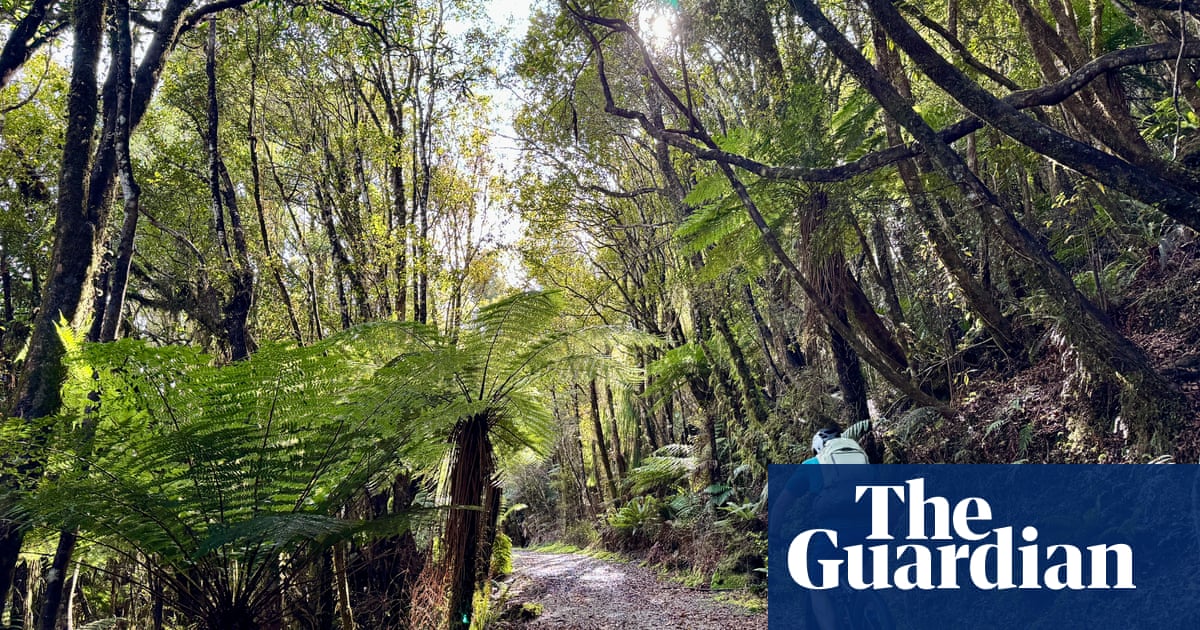New Zealand’s remoteWest Coast Wilderness Trailis something of an oxymoron: accessibly wild. It sounds nonsensical, but that’s exactly the experience.
The gently undulating gravel trail in the country’s most sparsely populated region is not only a beginner-friendly cycle, it’s also enjoyed by people with a wide range of physical abilities.
Natalie Gauld, 58, who was diagnosed with motor neurone disease in 2022, has completed the West Coast Wilderness Trail multiple times and contributed to the trail’saccessible ride guide. “It makes me feel capable,” said Gauld on a phone call before my trip. “I enjoy its remoteness.”
The 133km trail from Ross to Greymouth (or vice versa) is one of 23Ngā Haerenga Great Rides of New Zealand. It’s in the West Coast region, a narrow strip of land roughly 600km long wedged between the frozen Southern Alps and the palm-fringed Tasman Sea. Its diverse ecosystems bizarrely buddy up: icy slopes and glacial rivers with steamy rainforests and pebbly beaches.
Viewing the world from handlebars is the way my husband, Paul, and I typically like to travel. Long, short, challenging, easy-going; we’re not fussy once we’re immersed in the landscape on two wheels. Having said that, we are not fans of lugging our kit or working out the best places to stop, eat and sleep. Sowe joined three other riders on a five-day supported journeywith cycling and walking specialists Adventure South NZ, who took care of the tedious logistics and planned snack stops and short side hikes to severalWest Coast scenic spots.
A bridge closure meant we had to slice off the first 15km or so and saddle up on the road outside Hokitika in the lashing rain. “A real West Coast welcome,” said our tour guide, Tereza Unzeitigova. The soggy start was forgiven as soon as we ducked into the protection of a mossy native rainforest. The West Coast is the only part of New Zealand where significant tracts of lowland rainforest remain, which includes giant podocarp trees that hark back to Gondwanaland.
The boardwalk traversesLake Mahinapua’s wetlands, where the soundtrack was a sonic experience all its own. For the unversed, like me, it could have been anything from swans, ducks and royal spoonbills to bellbirds, tūī, kererū or cuckoos. A coastal hug back to our accommodation in Hokitika completed the first 20km.
“‘Coasters’ have to be more self-reliant because we’re geographically isolated,” said Adventure South NZ host Rob Pieper, who served the group a paddock-to-plate dinner of zucchini soup, organic beef goulash and vegetarian dahl with rice that evening at their architecturally designed off-grid home. “If we have an earthquake, we could be on our own for months.”
Pieper and his wife, Col, prepare cyclists’ meals for the tour group. It is a natural fit for the delightful tandem-riding couple originally from the Netherlands, who – along with managing their smallholding, situated on the coast at Ruatapu in a rare white heron habitat – “make it work” by guiding, nursing, catering and school-bus driving.
After a restful night at the Beachfront hotel in Hokitaka, we got a bird’s eye view of the native forest on awalk in the treetops, before continuing the ride on a narrow trail alongside the babbling waters of theKaniere water race. Before my trip, Gauld told me she can pedal her Motom here after “pinch points” on the trail were widened.
Following a homemade lunch in a repurposed woolshed with Rob and Col, we spent the remainder of the day riding the shores of Lake Kaniere and hiking into the azure awe ofHokitika Gorge. Its glacial waters carry precious pounamu (greenstone) from the mountains down to the sea.
Time-poor doctors Nikhil Patel, 36, and Anvi Butala, 31, chose the trail because it packs multiple experiences into a relatively short trip. In preparation for the ride, Butala found a hill near where she lives and rode it 10 times in one training session, she told me.
It helped her get to the top of a sunny 400m climb on day three. There, the deserted oddity of Cowboy’s Paradise plateau served a collection of ramshackle buildings split by a broad dusty road. The forest trail down from the plateau to Kumara was fun, fast and flowy. That night we stayed at the Theatre Royal, the West Coast’s onlyfully restored gold miners’ hotel withcreaky floors and cheekily named rooms such as “King Dick”.
On the final day, the icy crown of Akoari/Mount Cook came into view behind deserted, driftwood-laden beaches where blue penguins – the world’s smallest – hang out. A gusty finish around the harbour to Greymouth had us battling to keep our bikes upright. It didn’t deter 53-year-old road cyclist Litza Reed from Perth, who hired a hybrid bike for the trail. She said she’s buying a mountain bike as soon as she gets home.
Though the trail was over, the journey wasn’t: we still had the 30-million-year-oldPancake Rocks and Blowholesto marvel at, plus a meander along the tranquil trails of Paparoa national park, and a 20km pedal to break up our van journey back over the Alps to Christchurch the following day.
Our only criticism of the West Coast Wilderness Trail: we wish it were longer. But fortunately, we have 22 other New Zealand Great Rides to explore.
Air New Zealand, Virgin Australia, Emirates and Qantas operate direct flights into Christchurch from Sydney, Brisbane and Melbourne. TheTranzAlpinetrain (from $219) runs between Christchurch and Greymouth. Adventure South NZ trips include an optional van shuttle service from Christchurch to Greymouth. For mobility-impaired passengers, wheelchair hoists provide access to the cafe carriage from track level.
Adventure South NZ haselectric pedal-assist e-bikesfor hire.Their comprehensive FAQs0include required fitness levels.
ThePounamu Pathwayis a wheelchair-accessible immersive cultural experience in Greymouth. TheWest Coast Treetop Walkhas a wheelchair-accessible cafe and walkway.West Coast Scenic Waterwayseco cruise boat and accommodation are wheelchair accessible.
The writer’s Adventure South NZ trip was discounted
